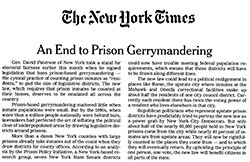Are legislative maps hurting prison reforms?
by Peter Wagner, November 12, 2010
Pam Adams has an excellent column in the Journal Star in Peoria Illinois: Are legislative maps hurting prison reforms?
She explains that gerrymandering districts around prisons helps makes reforming the budget-busting prison system more difficult. But unlike New York, Illinois’ districts with large prisons are evenly distributed between Republicans and Democrats. The bi-partisan support for retaining prison-based gerrymandering doesn’t make ending the practice any easier, but if Illinois wants to fair districts to guide the state for the next decade, reform is needed:
“The state has about 50,000 men and women in prison. Though most of the state’s prisons are downstate, most of the state’s prison inmates are from the Chicago area. Most of them will return to the Chicago area in less than two years. Counting prison inmates where they’re confined rather than where they live means Chicago basically exports political power to prison-padded districts downstate.
“We ought to be a bit more grateful to Chicago down here. Especially with a round of legislative redistricting on the horizon and downstate potentially in line to lose yet another Illinois House seat because population hasn’t kept up with the competition.
“Except it’s not fair. Not to the prison inmates who can’t vote. Not to voters in districts that don’t have prisons. Not to basic democratic principles.
“And it definitely doesn’t provide much political incentive to pass reforms that would reduce the more than $1 billion annually the state spends on prisons.”
Read the entire column: Are legislative maps hurting prison reforms?
See also our Organizing Against Prison-Based Gerrymandering in Illinois page for more research, fact sheets and news coverage. Or see Pam Adams earlier column about prison-based gerrymandering: Where should prisoners be counted?.
 The New York Times cites our research on prison-based gerrymandering in the
The New York Times cites our research on prison-based gerrymandering in the 


